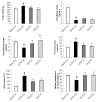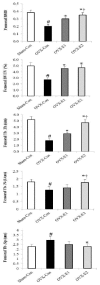The effects of downhill and uphill exercise training on osteogenesis-related factors in ovariectomy-induced bone loss
- PMID: 29036760
- PMCID: PMC5643207
- DOI: 10.20463/jenb.2017.0010
The effects of downhill and uphill exercise training on osteogenesis-related factors in ovariectomy-induced bone loss
Abstract
Purpose: Recent evidence suggests that regular exercise training plays a decisive role in maintaining homeostasis and promoting muscle and skeletal formation. However, the effect of downhill exercise training on osteogenesis-related factors is not well understood.
Methods: Thus, we investigated the effect of uphill and downhill training on ovariectomy (OVX)-induced bone loss. After ovary removal, the exercise method performed included uphill (16 m/min, +15°) and downhill training (16 m/min, -15°) for 60 min/day and 5 days/week, respectively, for 8 weeks.
Results: Our results showed that both uphill and downhill training significantly decreased the body weight, total cholesterol, and creatine kinase (CK) levels in the context of OVX-induced bone loss. On the contrary, levels of an osteogenesis indicator, osteocalcin and alkaline phosphatase were elevated. Consequently, the uphill and downhill training reduced OVX- induced bone loss in the distal femoral metaphysis. Likewise, the bone microstructure in OVX-induced bone loss was enhanced upon training. In particular, the inhibition of RANKL-induced osteoclast formation and osteoclast-specific gene expression improved upon downhill training compared to uphill training.
Conclusion: These results suggest that the uphill and downhill exercise types appeared to positively affect the expression of osteogenesis-related factors along with bone density and microstructure. Particularly, the downhill training has more beneficial effects on the maintenance of homeostasis during bone formation.
Keywords: Bone formation; Bone mineral density; Osteogenesis; Ovariectomized rat; Trabecular bone.
©2017 The Korean Society for Exercise Nutrition
Figures




Similar articles
-
Gradual downhill running improves age-related skeletal muscle and bone weakness: implication of autophagy and bone morphogenetic proteins.Exp Physiol. 2016 Dec 1;101(12):1528-1540. doi: 10.1113/EP085852. Epub 2016 Nov 13. Exp Physiol. 2016. PMID: 27641238
-
Additional weight bearing during exercise and estrogen in the rat: the effect on bone mass, turnover, and structure.Calcif Tissue Int. 2006 Dec;79(6):404-15. doi: 10.1007/s00223-006-0045-z. Epub 2006 Dec 8. Calcif Tissue Int. 2006. PMID: 17160577
-
Jumping exercise preserves bone mineral density and mechanical properties in osteopenic ovariectomized rats even following established osteopenia.Osteoporos Int. 2017 Apr;28(4):1461-1471. doi: 10.1007/s00198-017-3905-7. Epub 2017 Jan 26. Osteoporos Int. 2017. PMID: 28124728
-
Fatigue associated with prolonged graded running.Eur J Appl Physiol. 2016 Oct;116(10):1859-73. doi: 10.1007/s00421-016-3437-4. Epub 2016 Jul 25. Eur J Appl Physiol. 2016. PMID: 27456477 Review.
-
Synthetic half-reactions.Chem Sci. 2020 Sep 9;11(46):12423-12427. doi: 10.1039/d0sc03876h. Chem Sci. 2020. PMID: 34094448 Free PMC article. Review.
Cited by
-
The Effect of Moderate-Intensity Treadmill Exercise on Bone Mass and the Transcription of Peripheral Blood Mononuclear Cells in Ovariectomized Rats.Front Physiol. 2021 Oct 29;12:729910. doi: 10.3389/fphys.2021.729910. eCollection 2021. Front Physiol. 2021. PMID: 34777002 Free PMC article.
-
Ramadan fasting and exercise combination therapy: A novel approach for osteoporosis prevention in ovariectomized rats.Front Physiol. 2024 Oct 23;15:1403772. doi: 10.3389/fphys.2024.1403772. eCollection 2024. Front Physiol. 2024. PMID: 39507513 Free PMC article.
-
Downhill Running: What Are The Effects and How Can We Adapt? A Narrative Review.Sports Med. 2020 Dec;50(12):2083-2110. doi: 10.1007/s40279-020-01355-z. Sports Med. 2020. PMID: 33037592 Free PMC article. Review.
References
-
- Golob AL, Laya MB. Osteoporosis: screening, prevention, and management. Med Clin North Am. 2015;99:587–606. [Golob AL, Laya MB. Osteoporosis: screening, prevention, and management. Med Clin North Am. 2015; 99: 587-606.] - PubMed
-
- Kannus P, Parkkari J, Niemi S, Pasanen M, Palvanen M, Järvinen M, Vuori I. 2000. Prevention of hip fracture in elderly people with use of a hip protector. N Engl J Med. 2000;343:1506–13. [Kannus P, Parkkari J, Niemi S, Pasanen M, Palvanen M, Järvinen M, Vuori I. 2000. Prevention of hip fracture in elderly people with use of a hip protector. N Engl J Med. 2000; 343: 1506-13.] - PubMed
-
- Liu G, Peacock M. Age-related changes in serum undercarboxylated osteocalcin and its relationships with bone density, bone quality, and hip fracture. Calcif Tissue Int. 1998;62:286–289. doi: 10.1007/s002239900432. [Liu G, Peacock M. Age-related changes in serum undercarboxylated osteocalcin and its relationships with bone density, bone quality, and hip fracture. Calcif Tissue Int. 1998; 62: 286-289.] - DOI - PubMed
-
- Currie JL, Harrison MB, Trugman JM, Bennett JP, Wooten GF. Postmenopausal estrogen use affects risk for Parkinson disease. Archives of Neu Rology. 2004;6:886–888. [Currie JL, Harrison MB, Trugman JM, Bennett JP, Wooten GF. Postmenopausal estrogen use affects risk for Parkinson disease. Archives of Neu Rology. 2004; 6: 886-888.] - PubMed
LinkOut - more resources
Full Text Sources
Other Literature Sources
Research Materials

